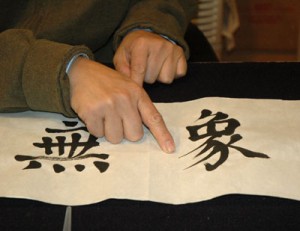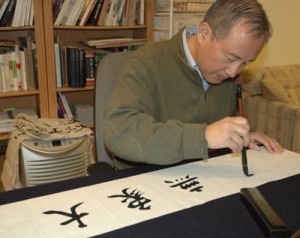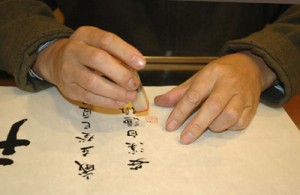
Qianshen Bai is a demanding teacher. Leaning over his apprentice’s brush work, he points out tiny things, “This is the problem. Her problem here is that here, so far so good, and she move this way, see the brush toward this part? The stroke should keep in the same direction. You see? You need to use finger and wrist. . . This kind of work is an illusion. The trick is, where this stroke came from, because calligraphy is art of movement.”

Although there are still quite a few people who practice calligraphy for leisure, very few take the time to study, in depth, the history and various aspects of the art of writing calligraphy. Mei Hung, Executive Director of Chinese Culture Connection, is one of those people. In September 2013, Qianshen Bai and Mei Hung were awarded a Traditional Arts Apprenticeship by the Massachusetts Cultural Council.
In addition to learning the subtleties of the techniques in writing balanced and artistic calligraphy, Mei Hung learned to appreciate a piece of good work with a critical eye. During their 8-month apprenticeship, Mei was introduced to writing couplets, horizontal banners, and, in a smaller font, on fan shaped calligraphy. In addition to learning how to compose the writing in various styles, she completed the composition with date and signature, and the proper way to apply the seal.


For Mei Hung, having had such a direct experience with master calligrapher Qianshen Bai has been a privilige. “Now I understand that the art of writing calligraphy can be related to playing music, practicing Tai Ji . . .To do it well is a total harmonious relationship among one’s intent, the brush, the ink and the paper. Professor Bai described it this way: the “brush dances and the ink sings.”

This apprenticeship enhanced my knowledge of the art and improved my writing skills, but most importantly, it made me feel humble. It is truly an art that requires a life long practice.” Perhaps, most importantly, Mei mastered a method of how to learn calligraphy by herself in the future.
The next deadline for Traditional Arts Apprenticeship grants is April 2014.
